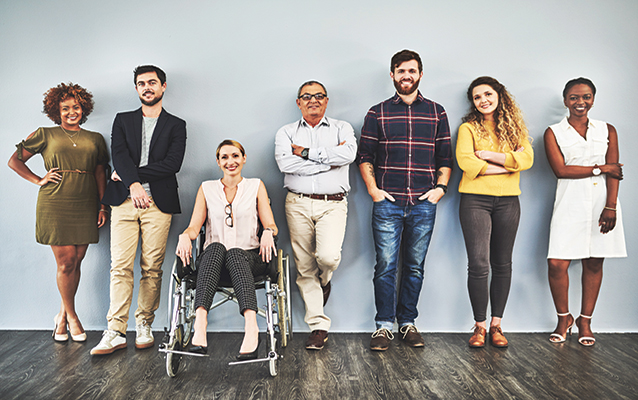According to the Centers for Disease Control and Prevention, one in four adults in the United States live with some type of disability that impacts major life activities, making it difficult to access adequate health care, actively participate in their communities and gain employment in the workplace.
Many experts consider persons with disabilities the most marginalized group in society. It’s not only the largest minority group in the United States, but also one that anyone can join at any time — at birth or as the result of an accident, illness or the natural aging process.
Although the Americans with Disabilities Act (ADA) was passed 33 years ago, which made it illegal to discriminate against individuals with disabilities in all areas of public life, many argue that progress hasn’t been sufficient. People with disabilities remain overrepresented among America’s poor and uneducated and a February 2023 Bureau of Labor Statistics report confirms that across all age groups, persons with a disability were much less likely to be employed than those with no disability. And oftentimes, it’s not the disability that is standing in the way.
“While barriers exist in our world in many forms toward people with disabilities, whether it’s stairs or narrow doorways or lack of testing accommodations in the classroom environment, the biggest barrier for individuals with a disability is stigma,” said Jill Bezyak, Ph.D., professor and program coordinator of UNC’s Rehabilitation Counseling and Sciences program.
Recognizing and overcoming stigma is the goal of a new research study Bezyak recently launched in partnership with the Rocky Mountain ADA Center (RMADAC). She’s hoping newly developed tools designed to mitigate negative bias toward people with disabilities are successful, providing them with more employment opportunities and ultimately, a better quality of life.
The RMADAC is one of 10 ADA centers across the country that work together as a national network to provide information, guidance and training on the ADA. While Bezyak has had a long-standing research partnership with the RMADAC dating back to 2009, the university assumed management of the center’s grant funding from the National Institute on Disability, Independent Living and Rehabilitation Research last March, making the RMADAC an official part of UNC.
Misperceptions and Myths Abound
As both an adjunct instructor and an alumna of the Rehabilitation Counseling and Sciences program, Jessica Mathis, ’15 is well-versed in the employment challenges for persons with disabilities from both the employer and employee perspective.
In her seven years working with the Colorado Department of Labor and Employment (CDLE) Mathis has served as a specialist helping employers navigate ADA requirements in apprenticeship programs and as a rehabilitation counselor helping persons with disabilities navigate employment opportunities. Her experience on both sides of the workforce has shown her first-hand how stigma can influence employment decisions and how education can change minds.
Employers often think that hiring people with disabilities will slow production or cost a lot of money. There’s also concern that workers with disabilities won’t be able to keep up or that the employer is setting them up to fail in an environment that can’t accommodate them. But research indicates those perceptions are far from true.
A recent report by the Job Accommodation Network indicated that most accommodations (58%) come at zero cost with the rest costing less than $500. Another report by Accenture, indicated that companies who employed persons with disabilities saw, on average, 28% higher revenues over a four-year period compared to their counterparts and that employees with disabilities offer benefits that include increased innovation, improved productivity and a better work environment.
Mathis said that after sharing these kinds of facts and education, employers often experience an aha moment and for the most part are thankful for the information and the opportunity to improve.
“Overcoming those barriers so that persons with disabilities have a full spectrum of options — if we can do that, we’re equaling the playing field,” Mathis said. “That’s empowering and it’s why the work I do is so impactful.”
Exploring New Interventions to Mitigate Bias
“Implicit bias toward persons with disabilities is a problem that has been well documented, and the goal of this type of research is to tell people that it’s out there and it’s a problem,” said Bezyak. “But what we’re doing now is trying to do something about it. We’re currently missing that link or intervention to not just raise awareness that the bias exists, but to shift that bias.”
Bezyak’s study will engage human resource professionals and law enforcement personnel, starting with a pre-test to measure both implicit and explicit bias. Participants then view an hour-long training that includes techniques to recognize, manage and improve bias, as well as testimonials from persons with disabilities, parents of children with disabilities and law enforcement personnel.
“The testimonials are powerful,” said Emily Shuman, director of the RMADAC. “It takes the training from a conceptual theoretical place and humanizes it. It illustrates how bias shows up in the real world.”
The training videos are immediately followed by the explicit bias questions again and then three months later with the implicit bias questions. Bezyak said research shows that implicit bias isn’t going to change in an hour’s time, but three months down the road could yield progress.
“The hope with this is that we will be able to get people to understand that biases have an impact on the experiences and lives of people with disabilities,” said Shuman. “If we can start to challenge our preconceived notions around disability, that can lead to people with disabilities having better outcomes in terms of employment, education, housing, getting paid, fair wages — all of those things. That will lead to a more inclusive society as a whole.”


